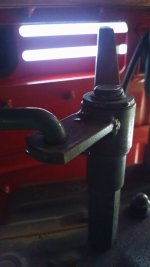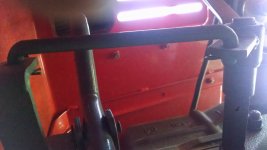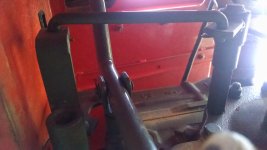Can't multi-quote here, but to address hi-lo responses from to posters....
I have sprayed linkage, but will try again.. the strange thing about it is when I do the shift I...
shut down the machine
set brake
crawl under with a small adjustable wrench.
open the jaws where the jaws will slip over the bent, fabricated linkage and move the linkage to "shift' from lo to hi or vice versa
this takes very little effort and the shift lever by the seat also moves as it should.
as this operation does not take any semblance of extraordinary effort, I cannot really say the linkage is frozen.... and the adjustable wrench
does not provide any more mechanical advantage than the long lever to the seat area.
I personally feel the geometry is wrong... and the stamped lever to the seat is weak... but mostly a geometry problem with linkage.
I will give the lube a go again next time I have tractor in my shop. BTW.. stored under cover in dry, but not enclosed.
I totally agree. All the linkages I looked at have poor geometry.
Worse, many of them have designs that are extremely prone to rust, wear, debris. This would hinder any shifting movements and interrupt the linkage function.
I went back underneath with my camera and a note book.
For the high low shift, instead of moving the transmission directly, which would mean one moving part, there is a series or a chain of moving parts. I believe they did that as a linkage system to cover the distance and to change a moving lever into a circular motion. But in their design instead of one or two moving parts, there are 4. All 4 for this singular shift, must be lubricated. And this one is exacerbated by two pivot points connected to the transmission. Both of these are moving in a circular direction or an arc. Then there are two very short lever arms attached to each of the pivot points (moving in a circle or arc). The lever arms are then connected by a straight arm. All this to get a part to move in a half circle or arc going into the transmission. There's a lot to go wrong here. Others are still correct, that if you lubricate "every moving thing" underneath, you will probably be OK. But I think the design is prone to these problems. It appears the same engineer designed all the Kioti linkages, they all use the same concept.
I went underneath with the phone camera.
One picture shows how they convert horizontal movement to circular. They weld a piece and put a short lever arm and then attach the horizontal bar to it.

This picture below, shows the pivot point.
I am looking from below upwards and you can look up the shifter arm. The light coming down from the slot above where the shifter arm goes from above to below.
This is where the lever from above actually connects.
It's a sleeved arm. So debris and rust can get inside of the sleeve and stop your shifter from moving.
This is the first moving part. Probably the most vulnerable to the damages from time, weather, use, etc.

The below picture shows how short these lever arms are that are welded to the part that needs to move in a circular fashion:

Other pictures show the linkage, end-to-end. The picture is quite large and you must move it around to see the entire view. (sorry about that)

I worked in engineering for a very long time, so although not a mechanical engineer, I have a bit of the slide rule in the shirt pocket stigma. I looked at it and couldn't believe how it was designed.
Very little can stop or impede shifting, including rust or debris, or any type of kinking anywhere in the linkage.
It would be difficult to speculate your specific issue without spending time underneath. Maybe dirt or some kind of debris got into one of the many links in the chain. Look very carefully. Or perhaps high air pressure to clean it all out. Then look carefully at each junction?
My recommendation is to take the entire linkage apart from below. Especially the major sleeved pivot point that the shifter arm from above first connects to. It's a sleeved unit and I can imagine that debris gets inside the sleeve. Also check all the cotter pins that none have bent and there's no mechanical interference. Lubricate everything thoroughly, then put it back together.
So please Keep us posted.




